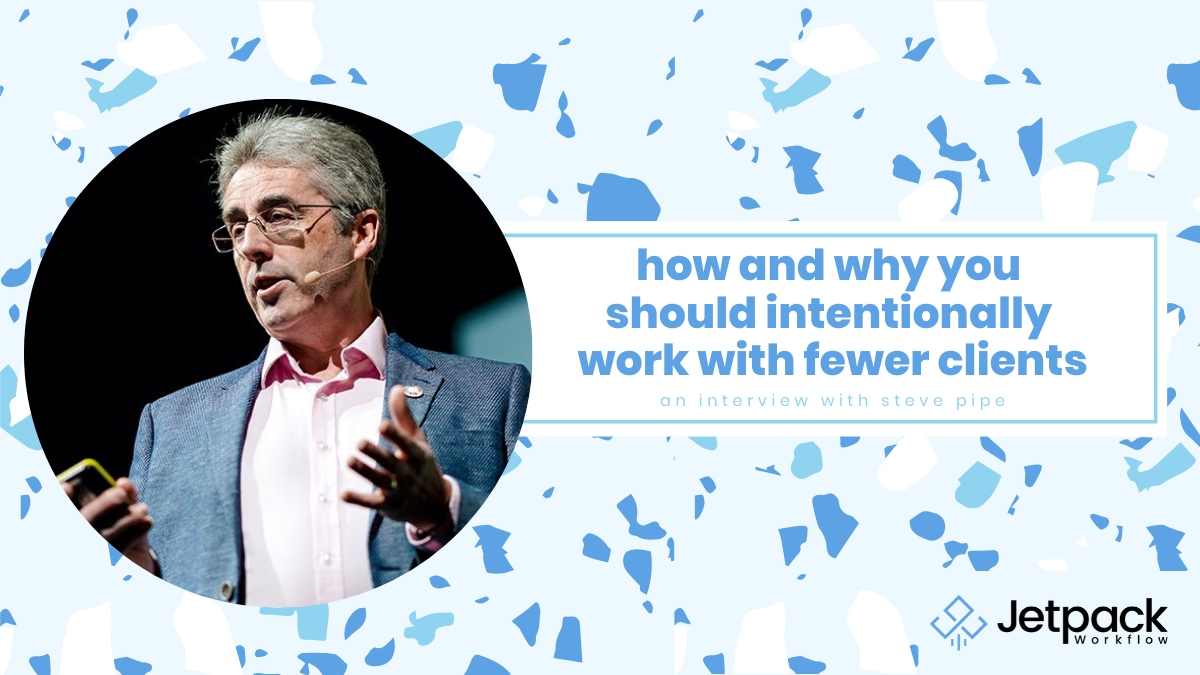How And Why You Should Intentionally Work With Fewer Clients

We all desire to serve our clients in better ways. In implementing high impact strategies, we can add great depth to the client relationship while growing the business. This week’s guest is Steve Pipe, Founder of ImproveYourPractice, and we dive into how to deliver proactive value to your clients, charge premium fees, and right-size your client base.
In this episode, we cover…
- How (and Why) You Should Intentionally Work with Fewer Clients
- How to Build Greater Connection and Increase Prices with Your Client Price
- How to Build Recurring and Predictable Revenue for Your Firm
and so much more:
Resources mentioned in the episode:
- http://improveyourpractice.co.uk/
- Linkedin: https://www.linkedin.com/in/stevepipe
- Reach out to Steve : steve(at symbol)stevepipe.com
- Steve’s Books
================
We all know how stressful the life of a CPA accountant can be, especially during the busy season. We work incredibly hard over long hours during the week, and that work creeps into the weekend. The volume of work – it never ceases to end – wears us down, and we feel unappreciated by clients. Plus we are working to deliver what now seems to be a commoditized service.
But that can all change. You can intentionally choose to work with fewer clients, therefore build greater connections and increase your prices.
This advice is from Steve Pipe who is known as the world’s most highly rated advisors to accountants. He is the Founder of ImproveYourPractice.com. Steve is an industry speaker, strategist, and author, and has over 470 LinkedIn testimonials and counting.
“Accountants are the heart of the business communities and are making the business community more successful,” Steve observes. So why does the industry see their role as a backwards note-taker, he wonders.
His suggestion is for accountants to deliver premium services. The “root of issues” are that “accountants simply don’t charge enough,” says Steve.
Premium Price Your Services
With low rates, doing an “incredibly good job” can be at risk. “Income, work-life balance, or service quality” are negatively affected, and it is inevitable all three will be compromised,” Steve thinks.
In his Blueprint for Better Accounting Practice work, Steve found that in a sampling of industry work, over 40% of cases in the UK there were mistakes, errors, omissions, and 30% of those are judged to be major errors.
Steve tells the industry to have the “courage to stand up for premium service.” “We hide behind the illusion that there is a market price. We can’t charge more than the market price. We will lose our clients.”
But he finds a huge variation of prices across the board. “Price is a choice.” In making better pricing choices, you will have the time and the money and the budget to deliver premium services.”
Increase your prices, implement value-based pricing, and reduce the number of clients.
By charging higher prices, you will find the quality of clients improves and you have less of the hassle. As a result, you receive better monetary rewards and better emotional rewards.
And that pricing is justified through the quality work you deliver.
More than anything else “we are experts in numbers,” says Steve. Accountants used to get paid for adding numbers up. “All that stuff is now being done with the push of the button.”
So now what we provide to our clients is an analytical, strategic layer of advisory. Use your skills with numbers to help clients interpret and make better decisions with those numbers.
In short: Connect, collaborate, and leverage the cloud to reduce time.
“Cloud technology is bringing the accounting profession in the crossroad,” says Steve. It “just makes things easier than ever before.”
Deliver Proactive Value in 5 Easy Steps
You can stand out to your clients in a great way through the style of your proactive services and the integrity of your work.
“Clients want for their accountant to be genuinely proactive,” notes Steve.
Although in his many years of training the accounting industry, Steve realized that there was no shared understanding for what being proactive means.
He believed it was critical to define the word “proactive.” So he did, basing the determination from his extensive work with the industry.
Ready to learn how to proactively provide services to your clients? Find out how in 5 easy steps according to Steve:
- Step 1: Do something before your client requests it. Be proactive, not reactive.
- Step 2: Make that deliverable specifically relevant to their circumstances. “A newsletter does not cover it,” because it is not specifically relevant to every client
- Step 3: Make that deliverable highly valuable so that it is “a real difference to their business, to profitability, to life.”
- Step 4: Do not “ambush bill” your client immediately after this deliverable. “The bill will not be expected” and “it just un-done all the good you did.” Although Steve says you could charge the client in the second instance of this deliverable. Performing the work pro-bono for the first time can be to your advantage. Either it builds goodwill (an emotional reward to you) or the client will ask “can I buy that service from you” (a financial reward to you). In essence, you “made a sale without selling.”
- Step 5: Make this process systematic so you can repeat the process “every time for every client.”
Steve says this process is incredibly powerful and it leads the way for you to become trusted advisor to your clients.
Focus on the 8 Areas of Client Business
Now the 8 business areas in which you can apply your systematized process to proactively deliver value to your clients can be found in:
- Proactive profits
- Cash flow
- Personal income
- Magnitude of tax position
- Value of business
- Personal wealth
- Work life balance
- Key family members financial position.
However, Steve says that to be able to proactively deliver work to your clients in these areas, you need to rely on your 3Cs: Confidence, Credibility, and Competency.
Building Your Business Self-Confidence
What happens if you do not have courage and self-confidence to perform your best for your clients? “Until we believe that we are great and confident in our abilities, nothing is going to work,” says Steve
We will not be able to deliver great work if we “lack courage on our convictions to see things through.” It all starts with self-confidence and self-belief.
Convince yourself! “Because when you believe it, then your clients will believe the same thing,” Steve assures.
Systematically build self-confidence and capture Ideas. Then Steve recommends using that agenda when you meet with clients.
So to get there, Steve suggests to:
- Reflect on skills, knowledge, insights you have
- Understand what differences you made
- Remember all of the fantastic things you have done and learned and how you overcame
- Think about what you read in books, how you can start to make a difference in those 8 areas, in the additional ideas and in services you can offer
- Identify what is highly valuable to your client
- Explore potential ideas for advice
Now make a list of what you just uncovered.
From there, create case studies of your completed work, collect client testimonials and success stories, and showcase specific improvements you made for businesses.
“It’s about being systematic. It’s about saying ‘this is so important: Being proactive, justifying premium prices, changing the strategy of the firm. That it’s worth investing time, in creating those lists, building them into our system.’”
Steve continues by saying that it’s all about “practicing, getting better, [gaining] more and more self confidence, and sharing those ideas with client. Then little by little, bit-by-bit, it gets better. “
The Importance of a Written Agenda
Now take what you learned and go wow your client!
Arrange a meeting and come prepared with a written agenda you created ahead of time.
“Having a written agenda is actually one of the most important bits of preparation. It’s important so that the client knows you care enough to have thought about the meeting before the meeting and prepared for it,” says Steve.
“Interaction with client is fundamentally different when you have a written agenda. “
Clients switch from one accountant to another because they may believe you do not care about their needs. Steve attests that “a written agenda proves you care.”
In devising your written agenda, it will be up to you to design the purpose of the meeting. It can be a systematic and strategic approach, covering the things that you want to cover. Include your feedback, testimonials, and referrals while you are at it.
But Steve says the most important line in any written agenda: What issues or concerns the client wants to address. This point cannot be the last point on the agenda. Start with that question first before all else: “Is there anything else specific you want to cover today?”
Be proactive and confident in your abilities, and the sky is the limit in what you can accomplish for yourself and your clients.
Related Articles:






